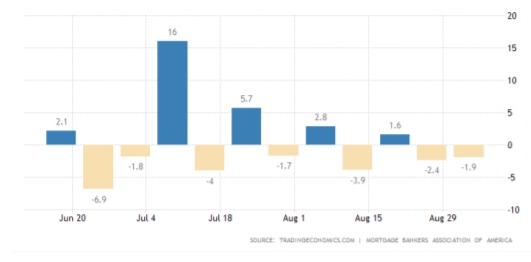Mortgage Applications Drop Again
The Mortgage Bankers Association releases a survey that covers over 75 percent of all U.S. retail residential mortgage applications and has done so every week since 1990. Wall Street pays attention to this survey because it provides a gauge for housing demand and the overall economic climate. Look at it this way: when people feel confident enough to buy a house, it is very likely that they are more confident in their own financial situation.
But the housing market has a direct impact on so many other aspects of the economy too. Housing impacts construction jobs as well as consumer spending on items like refrigerators, washers, dryers and furniture.
Lowest Level Since July
On September 8th, the Mortgage Bankers Association reported that its Market Composite Index, a measure of mortgage loan application volume, decreased 1.9% from the previous week. This is after a 2.4% drop the week before. Further:
- The Refinance Index decreased 3% from the previous week and was 4% lower than the same week one year ago.
- The seasonally adjusted Purchase Index decreased 0.2% from one week earlier.
- The unadjusted Purchase Index decreased 3% compared with the previous week and was 18% lower than the same week one year ago.

“Mortgage application volume fell last week to its lowest level since mid-July, as mortgage rates have stayed just above 3% for several weeks. Refinance volume has been moderating, while purchase volume continues to be lower than expected given the lack of homes on the market.”
“Economic data has sent mixed signals, with slower job growth but a further drop in the unemployment rate in August. We expect that further improvements will lead to a tapering of Fed MBS purchases by the end of the year, which should put some upward pressure on mortgage rates.”
Mortgage Interest Rates Remain Low
- The average contract interest rate for 30-year fixed-rate mortgages with conforming loan balances ($548,250 or less) remained unchanged at 3.03 percent, with points decreasing to 0.33 from 0.34 (including the origination fee) for 80 percent loan-to-value ratio (LTV) loans. The effective rate decreased from last week.
- The average contract interest rate for 30-year fixed-rate mortgages with jumbo loan balances (greater than $548,250) increased to 3.14 percent from 3.13 percent, with points increasing to 0.30 from 0.26 (including the origination fee) for 80 percent LTV loans. The effective rate increased
from last week.
- The average contract interest rate for 15-year fixed-rate mortgages decreased to 2.37 percent from 2.39 percent, with points decreasing to 0.26 from 0.30 (including the origination fee) for 80 percent LTV loans. The effective rate decreased from last week.
- The average contract interest rate for 5/1 ARMs decreased to 2.56 percent from 2.80 percent, with points increasing to 0.17 from 0.13 (including the origination fee) for 80 percent LTV loans. The effective rate decreased from last week.
More Data Later in the Week
More economic data will be released later this week, including Jobless Claims on Thursday and Wholesale Inventories on Friday.




